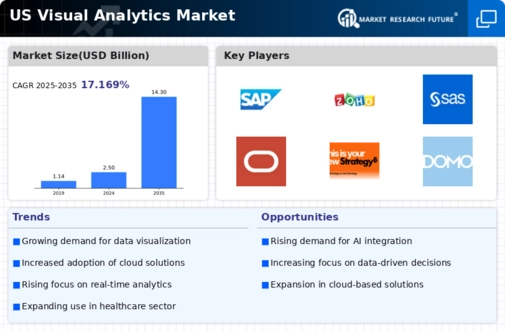The visual analytics market is currently characterized by a dynamic competitive landscape, driven by the increasing demand for data-driven decision-making across various sectors. Key players such as Tableau Software (US), Microsoft (US), and Qlik (US) are at the forefront, leveraging their technological prowess to enhance their offerings. Tableau Software (US) focuses on innovation through continuous product enhancements, while Microsoft (US) emphasizes integration with its broader suite of cloud services. Qlik (US), on the other hand, is strategically positioned through partnerships that enhance its data integration capabilities. Collectively, these strategies contribute to a competitive environment that is both collaborative and competitive, as companies seek to differentiate themselves through advanced analytics capabilities.
In terms of business tactics, companies are increasingly localizing their operations to better serve regional markets, optimizing supply chains to enhance efficiency. The competitive structure of the market appears moderately fragmented, with several players vying for market share. However, the influence of major companies is substantial, as they set industry standards and drive innovation, thereby shaping the overall market dynamics.
In October 2025, Tableau Software (US) announced a significant partnership with a leading cloud provider to enhance its data visualization capabilities. This strategic move is likely to bolster its market position by providing users with more robust tools for data analysis, thereby attracting a broader customer base. The partnership underscores Tableau's commitment to innovation and its focus on integrating advanced analytics into cloud environments.
In September 2025, Microsoft (US) launched a new AI-driven analytics feature within its Power BI platform. This feature aims to automate data insights, making it easier for users to derive actionable intelligence from complex datasets. The introduction of AI capabilities not only enhances user experience but also positions Microsoft as a leader in the integration of artificial intelligence within visual analytics, potentially increasing its market share.
In August 2025, Qlik (US) expanded its operations by acquiring a smaller analytics firm specializing in machine learning technologies. This acquisition is expected to enhance Qlik's product offerings and strengthen its competitive edge by integrating advanced machine learning capabilities into its analytics solutions. Such strategic moves reflect a broader trend of consolidation within the market, as companies seek to enhance their technological capabilities and market presence.
As of November 2025, the visual analytics market is witnessing trends that emphasize digitalization, sustainability, and the integration of AI technologies. Strategic alliances are increasingly shaping the competitive landscape, as companies collaborate to enhance their technological capabilities and market reach. Looking ahead, it appears that competitive differentiation will evolve, with a shift from price-based competition to a focus on innovation, technology, and supply chain reliability. This transition suggests that companies that prioritize these aspects are likely to thrive in an increasingly competitive environment.

























Leave a Comment